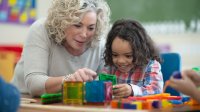What a Culture of Caring Looks Like in Early Childhood Classrooms
A commitment to fostering an environment of caring can promote learning in culturally diverse pre-K to 2 classrooms.
Your content has been saved!
Go to My Saved Content.What does it mean to care? How can pre-K to 2 teachers have a genuine caring relationship with their learners? Caring relationships are motivated by mutual empathy, based on the understanding and recognition of others and their needs. In the early learning classroom, caring is present in the relationship between children and teacher: Teachers respond to children’s needs and interests when they adapt and design a differentiated curriculum.
When they truly care for children, teachers meet students’ social and academic realities and create opportunities for deep, meaningful, and relevant learning. Caring enhances the child-teacher relationship, especially in a culturally diverse classroom. Being in a constant caring relationship motivates children to learn.
Although caring may be intrinsic to teaching, it’s important that teachers reflect on the implications that caring has for their teaching practice, and question and reflect on how much their caring habits are culturally inclusive and responsive.
Building a Circle of Caring in a Culturally Diverse Classroom
Teachers can respect, dialogue with, and consider each child’s social and cultural background to model and promote caring in the classroom, and they can include opportunities for teaching children to practice and reflect on their own caring habits. Teachers can do this by listening to their students, giving them a voice, and encouraging them to share their stories.
Listening: A teacher who cares is an attentive one, who talks with students, provokes critical thinking and reflective responses, and makes thoughtful connections among school disciplines and life experiences. In my teaching practice, I often connect classroom subjects to facts of different cultures. While talking about plants, colors, historical facts, or geographic elements, for example, I engage children to connect their cultural background to what I’m teaching, aiming for meaningful learning.
A caring teacher is one who listens. Listening is a responsibility that’s emotionally and intellectually important. Provide a secure environment so that students can feel they matter and they’re being heard.
To listen to someone is to move beyond the conversation in which one speaks and the other listens. Listening in teaching consists of recognizing and connecting with the students, with their experiences, and with their social and cultural backgrounds.
Voice: It’s important that teachers acknowledge the social, cultural, and ethical responsibility they have in nurturing and maintaining caring relationships as well as welcoming the children’s voices and making them feel their stories are valued by creating a safe space for them to be heard.
It’s also critical to promote and engage children in self- and social awareness, as these are important steps in promoting a more inclusive classroom. I created a memory game with pictures of different people that the children have to match with cultural elements, such as musical instruments, clothing style, or typical food.
I also created a “cultural Bingo game,” using pictures of people of different nationalities. When I refer to a specific picture, I provide clues such as “the person has black curly hair and wears glasses” or “the person has brown skin tone and long black hair.” After choosing their options, the children and I discuss our similarities to and differences with the person in the picture.
These activities exemplify caring and can widen the teacher’s lens on their curriculum and their teaching practices, promoting and enhancing sustainable and respectful relations among children, their stories, and the diverse society they live in.
Sharing stories: Supported by a caring relationship, children feel safe sharing their stories. I bring movies and picture books to class to further engage students. While presenting these materials, I ask questions about the characters’ qualities and whether the learners can relate to them, the setting, and the main idea. To further engage the learners, I also ask how they would tell their stories and what main ideas they would include.
As a first step, they narrate their stories to one another. As a second step, the children and I use technology tools to draw, record, or (using pictures) animate their stories. While sharing their stories, children are building a caring community, promoting empathy for one another and supporting each other’s emotions and responses. As a result, children are able to identify and respond well regarding their and others’ feelings. These stories can also promote reflexive dialogue that both children and teachers can reflect on.
Assessment: Caring is not a single act. It requires practice and continuity. It also demands reflection on caring relationships and the way educators evaluate children. To assess the children in a caring way, teachers can collect relevant information from the learners’ stories, interests, and goals.
This way, the assessment is not only content focused but also learner focused, valuing the children’s thinking and emotional, cognitive, and academic learning and growth. In this process, teachers can reflect on not only “What has the child learned?” but also “How has the child been building their knowledge?” With this question in mind, I assess the children by how their social, emotional, and language skills have improved, and what new knowledge and concepts they learned while listening to others’ stories and connecting school subjects with cultural topics and elements.
When teachers personalize children’s learning by meeting their social, cultural, and academic realities, needs, and demands, they create an atmosphere that nurtures deep, meaningful, and relevant caring and learning.
